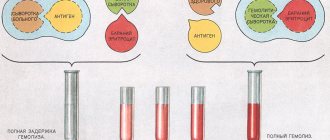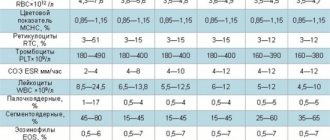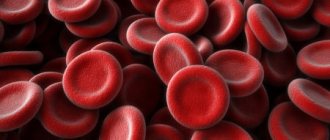What is this analysis?
In the body, in response to the introduction of pathogenic microflora or when its own cells are damaged, special protein elements are formed - antibodies. When diagnosing syphilis using the microreaction method (MRP) in the patient’s blood, they try to find the connection between antibodies and phospholipids - proteins that make up all cell membranes.
An immune response in the form of antibody production is formed precisely when phospholipids from cell membranes enter the blood. This occurs when Treponema pallidum, the causative agent of syphilis and a number of other infections, penetrates human tissue.
It takes a certain amount of time for antibodies to begin to be produced when infected with syphilis. This does not happen instantly, but, at the earliest, 3-4 weeks after infection. This is why this test is not suitable for early diagnosis. But due to the ease of implementation and low cost, MRP is classified as a screening test designed to detect the disease among the general population.
Diagnosis of syphilis using this method consists of the following steps:
- preparing the patient for collecting material;
- donating blood in the laboratory. The analysis requires patient blood, which is most often taken from a vein, but in some medical institutions it is also used from a finger;
- using special equipment, blood plasma is separated from cellular elements;
- An antigen with a visualizing agent is added to the resulting biological fluid. Coal is most often used for this;
- If phospholipid antibodies are present in the serum, they stick together with the introduced antigen, which is manifested by the formation of black flakes, indicating a positive reaction. In the absence of antibodies to phospholipids in the body, flakes are not formed.
A quantitative assessment of the presence of Treponema pallidum in the body is also carried out with the calculation of titer indicators. For this purpose, microreactions to syphilis are performed in dilutions. During the research process, the patient's blood serum is diluted with saline solution, first twice, then four times, and so on, each time doubling the dilution and conducting a test to detect antibodies in the material. In this case, the dilution at which the microreaction last remained positive is noted. For example, 1:320 means that even with a dilution of 320 times, the blood serum still contains antibodies. This figure is an indicator of the titer and is indicated in the analysis. The higher the titer value, the more active the pathological process in the body.
Quantitative determination of the titer is important for monitoring the effectiveness of therapy and diagnosing the final cure of syphilis. Within a year after course therapy, there should be a 4-fold drop in titers. Control tests are carried out 3 months, six months and a year after treatment.
RW blood test: explanation, how to take it and what is it?
The results form includes pluses or minuses. The latter speak of a negative reaction and absence of illness. A positive reaction can be described with one to four plus signs. The transcript shows the stage of the disease:
- or – positive test;
- – weakly positive;
- – doubtful, requires double-checking.
If the RW analysis shows a negative result, this does not exclude that a person has syphilis at the first or third stage. Plus, a negative reaction may indicate the destruction of red blood cells. The secondary period of syphilis does not always show a positive result. In the first 17 days, the reaction can be negative, and only by the sixth week can it show, and even then only in 25% of patients with syphilis. After this, the reliability approaches 80%. Approximately 5% of healthy people show a false positive result.
If the test for RV is positive, this indicates the presence of antibodies to Treponema pallidum in the blood - that is, about 1.5 months have passed since the infection. Other reasons for results to appear on the form are:
- carrying out antisyphilitic therapeutic measures - reducing the acute process;
- pregnancy in the absence of the disease itself - the analysis will be weakly positive in approximately 1.5% of women;
- primary syphilis – 80% of cases at 6-8 weeks;
- secondary syphilis in 100% of cases;
- clinical relapse of the disease;
- tertiary period of the disease - in 75% of cases;
- early congenital syphilis.
RW negative
If you receive a negative test result, you can talk about the absence of infection and antibodies to syphilis in the body, but this is not always the case. In the early stages of the disease, the results will be negative because antibodies simply do not have time to develop. Plus, certain diseases and individual characteristics of patients influence the reliability failure.
Syphilis is the most famous and common infection that is transmitted through close contact of a patient with a healthy person. Very often, syphilis is transmitted through sexual contact, however, household infections also occur.
Transmission of syphilis
The likelihood of a pregnant woman infecting her child intrauterinely is very high. Most often, infection occurs during the secondary and primary periods of the disease. The tertiary period is not contagious.
The main symptoms of syphilis:
- erosion of oval forms (localized in areas where the pathogen is introduced, i.e. Treponema pallidum);
- syphilides;
- regional increase in the volume of lymph nodes.
The patient must undergo a test for RW to make an accurate diagnosis and prescribe a treatment regimen.
Indications for the study
Precipitation microreaction to syphilis is performed for diagnostic purposes and during screening studies. To identify and confirm the presence of Treponema pallidum infection, MRP analysis is prescribed to the following groups of patients:
- having clinical manifestations of the disease. First of all, these are patients with characteristic ulcerations on the genitals and areas of the body that come into contact with a partner during sexual intercourse. Attention is also drawn to enlarged lymph nodes located close to the lesion;
- persons with any rashes or sores in the genital area;
- sexual partners and family members of the patient;
- newborns born to mothers who are sick or have a history of syphilis;
- patients with any other pathology transmitted through intimate contact.
Purpose of blood microreaction
The study is not a specific analysis, since it does not aim to find the pathogen. Cell destruction can also occur in other diseases. Therefore, if the test results are determined to be positive, other laboratory tests must be performed.
What does the analysis reveal?
Sexually transmitted diseases are caused by various pathogens. When they enter the body, the immune system responds by increasing the synthesis of substances that should fight them. In response to the multiplication of the pathogen, antibodies are produced that bind it. There should be as many antibodies as there are bacteria.
During the fight, Treponema pallidum or another pathogen destroys the membrane of its own cells. These residues also need to be removed, which is what the antibody responds to.
The analysis shows the presence of such components, their complexes, antibodies and antigens. Each of them can be quantified.
What is a microreaction blood test?
The full name of the test is microprecipitation reaction with cardiolipin antigen. This research method is classified as “non-treponemal”. The method is based not on the detection of the actual causative agent of syphilis, Treponema pallidum, but on the detection of antibodies to the lipoid antigens of the causative agent.
The antigen used in the analysis is bovine heart cardiolipin. This cardiolipin is similar to the phospholipids that make up the microbial wall of Treponema. If a person is or has been sick with syphilis, it means that antibodies remain in his blood. In this case, when a microreaction of precipitation is performed, antibodies bind to cardiolipin antigens and precipitate (precipitate).
Types of research
All nonspecific studies can be divided into two large categories: macro- and microreactions. The first is carried out without additional equipment and is assessed visually. The second requires equipment in the form of a high-magnification microscope.
Electron microscopy allows you to identify destroyed cells without the use of a reagent.
There are several types of blood tests for microreactions:
- rapid test with macroscopy;
- classical sediment research;
- quantitation.
The first method does not require examining the material under a microscope; the result is visible to the naked eye.
The essence of the analysis is that the patient’s blood is placed in a centrifuge, serum is obtained, to which a concentrated solution must be added. In the presence of a pathogen, the liquid becomes colored .
In the second method, blood serum is examined under a microscope; no additional substances are used. To obtain a quantitative value, the serum is diluted many times, then sent under a microscope, and the laboratory technician records the number of bound antigen-antibody complexes in the smear.
Indications for the study
Due to the simplicity of the study and the absence of the need to use expensive reagents, the microprecipitation reaction is used for large groups of the population, most often during routine examination.
The analysis is scheduled:
- military personnel;
- pregnant women;
- patients before surgery;
- during examination in a prison or pre-trial detention center;
- when examining medical workers and catering staff;
- before donating blood for donation;
- before organ transplantation.
During treatment, to monitor the effectiveness of the prescribed therapy, the study is carried out several times.
The quantitative reaction test is indicated for persons who show signs of pathology, children of sick parents, and for ulcers on the genitals. An examination is also needed to confirm the diagnosis after initial tests or if the patient has other sexually transmitted diseases.
Preparation
To get a reliable result, you must follow the rules for donating blood. There are several important points to consider.
In order not to provoke the release of excess hormones, the examinee must refrain from significant physical activity before blood sampling, from smoking, from alcohol the day before, and from fatty foods.
Blood donation occurs on an empty stomach, since lipids will appear as a film on top of the tube and may distort the result. The last meal should take place the day before at about 19 pm.
Blood sampling for research
For a microreaction, it is necessary to take capillary blood, that is, from a finger. It is subjected to centrifugation, that is, the clot is removed from the formed elements, leaving plasma. Additionally, blood is taken from a vein. If it cannot be taken, then cerebrospinal fluid will do.
The biological material is settled, plasma or serum is mixed with the antigen. At the same time, the progress of the reaction is assessed. The healthcare professional should monitor the fluid for signs of discoloration.
How long is a blood microreaction test valid?
Venous blood shows the presence of traces of the pathogen within 3-4 weeks after infection. The shelf life of the test depends on its purpose and the standards of the medical institution.
- During treatment, the outcome of the reaction is assessed every few weeks.
- The validity of the test for medical workers with a negative result is 12 months.
- After contact with a potentially sick person, it is necessary to conduct a test a month later, regardless of how long ago the previous study was carried out.
Decoding the result
While telling what it is - a blood microreaction, it is also necessary to mention how the results are deciphered. It may imply a negative, positive or dubious outcome.
Sometimes a false positive or false negative result is determined. The reasons for this phenomenon will be discussed below.
Positive result
This reaction is observed if flakes are found on the slide. This means that the serum contains antibodies that were produced against antigen fragments or cells destroyed by them.
The “+” result can be observed for a long time even after treatment, since it takes a considerable period to cleanse the blood of all fragments of treponemes and the remains of destroyed cells. But the antigen titer will make little difference.
A positive reaction may indicate that the patient has syphilis, has acquired seroresistance, or has residual effects after therapy. There are also false positive results.
Negative result
A negative reaction is observed if no changes have occurred on the slide and there are no flakes. This shows that there is no disease or it has already reached an advanced stage .
In some cases, the reaction is carried out too early, when there are no antibodies yet or their fraction is so small that it is not possible to evaluate the result as positive. This is a false negative reaction.
The patient calms down, believing that he is not sick, and learns about the infection when the clinical picture unfolds.
False positive result
Examination of the material may reveal the presence of a slight sediment, that is, there are few antibodies. This result occurs if you do not follow the rules for storing or collecting material, use non-sterile materials, or violate the preparation rules. Reliable results are obtained only if all recommendations are followed before testing.
A questionable analysis also occurs in the presence of certain diseases or conditions that the patient might not know about or keep silent about:
- pregnancy;
- tumor;
- diabetes;
- autoimmune processes;
- acute inflammatory process of the lungs;
- tuberculosis;
- alcoholism;
- gout;
- drug addict.
This research method, if the result is positive, does not mean that syphilis is confirmed. This is only a general, primary analysis that requires clarification. The reaction may show the presence of antibodies to other pathogens.
To confirm the diagnosis, treponemal tests are required - ELISA or RIA, based on the antigen-antibody complex. They allow you to determine treponema, the result of its activity and traces of vital activity.
Thus, the microreaction analysis allows us to determine the presence of antibodies to treponema, but is not specific. It is used to examine large groups of the population and allows us to identify healthy people and those who need additional, more complex tests.
Blood for microreaction (precipitation microreaction) is a so-called non-treponemal test. This reaction aims to detect antibodies in human blood that are produced against the lipids of cells damaged by the causative agent of syphilis, Treponema pallidum (anti-lipid antibodies).
Diagnostic methods
The action of this laboratory reaction is to detect antibodies to the causative agent of syphilis - Treponema pallidum. The fact is that when infected (most often through sexual contact or household contact), the human immune system is triggered, and in response to the penetration of a foreign biological agent, a large number of antibodies are released into the blood, aimed at fighting it.
It is very important to pay attention to any deviations in health in a timely manner and consult a doctor. In addition, it is necessary to remember that a real opportunity not only to maintain your health, but also to ensure the health of your loved ones is to donate blood for RW. What this is and what rules exist for donating blood, we will consider further.
The screening test for syphilis is a laboratory serological blood test aimed at identifying specific antibodies to phospholipids. They are produced by cells of the immune system due to the destruction of cells and tissues in the area where syphilis develops. This reaction is a non-treponemal test, since antibodies to the causative agent of syphilis (treponema pallidum) are not detected.
To detect syphilis or confirm its absence, different diagnostic methods and types of tests are used. The most informative and accurate research method is to study the patient’s venous blood. Biomaterial can be collected either from a vein or from a finger (depending on the type of laboratory and technique).
In some cases, detection of Treponema pallidum can be carried out using other samples:
- cerebrospinal fluid (a secretion produced in the spinal canal);
- contents of lymph nodes;
- ulceration tissue.
Diagnosis of syphilis occurs simultaneously using several methods.
Each of the existing tests is different in its information content and has certain advantages and disadvantages. Only the attending physician should decide which method to take the test for syphilis, taking into account the individual characteristics of the patient.
The most common way to diagnose syphilis is to perform a general blood test. This immunological procedure is called the Wasserman reaction. The test is classified as RSK (complement fixation test) and was first performed in 1906.
Interpretation of blood test on RW
It is based on the ability of venous blood to coagulate and form a complex when interacting with antigens. Modern RSK methods for detecting syphilitic infection differ significantly from classical RW. In fact, these procedures only have the same name.
The diagnosis is made taking into account whether antibodies indicating the presence of the disease are present in the test sample. Despite the fact that testing is as informative and reliable as possible, the possibility of a false positive reaction cannot be ruled out.
A false positive response is due to the fact that cardiolipin is initially present in the human body, but usually the immune system does not create antibodies against the native antigen. But medical practice shows that exceptions do happen. Most often this happens if a person has recently suffered a severe viral disease or has encountered the following diseases:
- pneumonia;
- kidney dysfunction;
- hematological diseases.
And also a false positive reaction often occurs during pregnancy, which is accompanied by a severe weakening of the immune system. If the specialist suspects that the testing showed a false positive result, the patient is prescribed additional advanced tests.
Today, this method of detecting syphilis in the blood is gradually replacing all other methods of diagnosing the disease. The microprecipitation reaction is a study whose mechanism is similar to the Wasserman reaction. But at the same time, the procedure is simpler and more informative - if the sample is contaminated, white flakes will certainly appear in it.
Another advantage of RMP is that blood for analysis is taken not from a vein, but from a finger. If more than 30 days have passed since infection, the technique is guaranteed to show a positive result. The risk of receiving false positive information during such testing is minimized and can only appear against the background of such violations:
- worsened infections;
- recent heart attack;
- cerebral hemorrhage;
- severe intoxication of the body.
Another common method for diagnosing syphilis is using venous blood. In order for RIBT to give the correct result, a few days before the delivery of the biomaterial, it is necessary to avoid taking antibacterial drugs.
This is due to the fact that most antibiotics, when they enter the body, block and suppress the activity of Treponema pallidum. A positive response from RIUT appears approximately from the middle of the second stage of infection and can persist even after the end of treatment.
This is what the causative agent of syphilis, Treponema pallidum, looks like under a microscope.
Many patients face such a problem that even after the end of treatment for syphilis, the analysis shows a positive result. A reliable clinical picture can be identified and assessed using ultrasensitive tests RIF (immunofluorescence reaction) and RIT (treponema immobilization reaction).
These analyzes are complex and time-consuming; they can only be carried out with expensive modern equipment.
RIF analysis for syphilis shows a positive reaction 2 months after infection. If the test shows a negative result, then the patient is healthy. Most often, RIF and RIT analyzes are done when the microprecipitation reaction is positive to confirm the reliability of the result.
ELISA and RPGA
The most informative and most accurate methods for diagnosing syphilis include ELISA (enzyme-linked immunosorbent assay) and RPHA (passive hemagglutination reaction) tests. The main advantage of these studies is that they are prepared within a short period of time.
RPGA gives a positive response within a month after infection and is most often performed simultaneously with non-treponemal and treponemal tests. Usually, with the help of RPGA, the primary form of the disease is diagnosed, accompanied by the appearance of ulcers and rashes. Since RPGA shows a positive reaction for a long time, the technique is rarely used to assess the effectiveness of the prescribed treatment regimen.
Enzyme immunoassay can show the presence of harmful microorganisms as early as 3 weeks after infection. A false positive result is rare and is most often associated with systemic pathologies or dysfunction of metabolic processes.
Types of analysis
The following types of microreactions are distinguished:
- Microscopic test. Its results are assessed using a light microscope.
- Macroscopic test. Evaluation of the results in this case occurs with the naked eye. Other names for this test are selection reaction for syphilis or express diagnosis of syphilis.
The precipitation reaction is used mainly to screen the population for syphilis, to diagnose and monitor the treatment of this disease.
When and how is a test for syphilis done?
Analysis for syphilis is one of the most popular studies in venereology. There are several different methods that have one thing in common - the general material selected for diagnosis. This is blood. It is the presence of the pathogen in the human circulatory system that is a mandatory diagnostic marker for making a diagnosis of Syphilis, since the presence of a clinical picture is not always sufficient for this.
Decoding the diagnosis without laboratory testing is sometimes difficult, since the course of the disease is characterized by periods of complete absence of its obvious manifestations. Syphilis is caused by Treponema pallidum, a gram-negative spirochete, entering the human body. This is a spiral-like microorganism. Due to its complete immunity to any aniline dyes used for staining in bacteriology, the pathogen was called treponema pallidum.
The main mechanism of transmission is sexual, but due to the ability of the spirochete outside the host body to maintain viability and virulence for about four days, contact and household transmission is also possible. During pregnancy, the pathogen is freely transmitted from mother to child, therefore, the placental barrier is not a hindrance for it.
The average incubation period is about 3 weeks. After this, the first characteristic sign of a developing sexually transmitted infection appears - chancre. These are erosions that form on the surface of the skin or mucous membranes, that is, in the place where the pathogen was introduced.
The ulcer is usually small, painless, with slight serous discharge. It can last up to one and a half months on average, and then disappears. This is followed by a period of two months, which is characterized by a complete absence of symptoms. At this time, a diagnosis can only be made if tested for syphilis.
Later, symptoms appear that are called “Secondary syphilis.” This is a general intoxication with increased body temperature, weakness and characteristic rashes. They also disappear after some time, and the disease enters the so-called latent period, which is characterized by the periodic appearance of secondary symptoms of the disease, and then their complete absence.
In the absence of proper treatment, syphilitic damage to internal organs occurs, that is, the disease develops into a tertiary form of infection. Patients with this disease are dangerous to others at any stage of the infectious process, and due to the presence of stages of asymptomatic carriage of the pathogen, it can only be detected by testing for syphilis.
If the data obtained shows or, a secondary blood sample is also necessary. Sometimes ORS (disease selection response) is used. To do this, blood serum is applied to a glass slide and a cardiolipid antigen is added. If the repeated result is positive, a visit to a venereologist is required to make an accurate diagnosis.
To prevent congenital syphilis in children, pregnant women donate blood for RW during all nine months: this test is one of the mandatory procedures for expectant mothers. If a pregnant woman becomes infected, comprehensive treatment is necessary during the first months. If treatment is neglected, the consequences are dangerous for both the mother and the unborn child.
Who should take a blood microreaction test?
During mass examinations and compulsory blood donation, the following groups of people are subjected to microreaction:
- Blood donors.
- Donors of internal organs used for transplantation.
- Pregnant women.
- Medical staff.
- Military personnel.
- Food industry workers.
- Any person undergoing treatment in a hospital.
- Patients awaiting surgical treatment.
- Prisoners in prisons and colonies.
In order to make a diagnosis of syphilis, it is necessary to conduct serological tests (treponemal tests for syphilis and quantitative microprecipitation tests).
These types of research are assigned to the following persons:
- With the presence of clinical symptoms of syphilis.
- People who have ulcers on the genitals.
- When in contact with a sick person or if you have a sexual partner with a history of this disease.
- Children who were born from sick parents.
- In the presence of other sexually transmitted infections.
- In order to confirm the results of a screening study (selection reaction).
To monitor the treatment of syphilis, the microprecipitation reaction is also used. Even after a person with syphilis has clinically recovered and is removed from the register, specific reactions can remain positive for a long time. These are the following reactions: ELISA, RIT, RPGA and others. They are the criterion of cure.
To carry out a microreaction, the starting material can be blood from a finger, from a vein, or cerebrospinal fluid. You should not eat before drawing blood.
The precipitation reaction can be:
- Negative,
- Positive,
- Doubtful.
Interpretation of blood test results for microreactions
It is known that antibodies to treponemal antigens can be detected in the laboratory in the blood three to five weeks after infection or ten days after the onset of chancre. Until this point, antibodies are not detected. The microreaction test is positive in approximately 80% of cases with primary syphilis and in 96% of cases with secondary syphilis.
After conducting the study, the laboratory technician writes on the form one of the possible results:
- Negative;
- Positive;
- Doubtful.
How is a negative result assessed?
So, a negative result means that the person is healthy. However, obtaining such a result cannot absolutely guarantee the absence of syphilis. Thus, the study can be carried out during a period when a person has just become infected, and antibodies have simply not yet appeared. Therefore, a negative result can also be observed with early primary syphilis. Moreover, this result is also typical for late tertiary syphilis.
How is a positive result assessed?
A positive result means that the person has syphilis (primary, secondary or tertiary). This result is also observed in people who previously had syphilis, but were cured.
By the way, when treating syphilis, the patient must periodically be tested for microreactions. Studying changes in antibody titer allows us to evaluate the effectiveness of treatment. Doctors regard a rapid decrease in titer as a criterion for successful therapy.
But it is also important to remember that precipitation microreaction is not a specific study. Antibodies to the cardiolipin antigen can also appear in other pathological conditions, causing the test to give false results. For example, the following conditions can give a false positive result:
In situations where antibodies are detected in the blood, but their titer is very low, then the result is written “doubtful” on the form. It is recommended to undergo a repeat examination after two weeks.
Thus, given that the microprecipitation reaction is not a specific test, if a positive result is obtained, a person is prescribed a specific treponemal test (RPGA, ELISA, RIF) to clarify the diagnosis.
Valeria Grigorova, doctor, medical columnist
10, total, today
What does a negative reaction result mean?
- Absence of syphilis disease.
- Late syphilis cannot be ruled out.
- The presence of primary seronegative syphilis.
- The reaction may be false negative.
Reasons for a false positive reaction:
- Causes related to improper reaction technique (improper blood sampling, bacterial contamination of the starting material, use of dirty reaction vessels, insufficient mixing, improper storage of material and reagents).
- Reasons associated with certain diseases, such as: tuberculosis, diabetes mellitus, cancer, chronic alcoholism, viral hepatitis, pneumonia, autoimmune diseases, gout, infectious mononucleosis and many others.
- Pregnancy can also cause a false positive result.
False negative results are much less common. They are most often associated with a high amount of antibodies in the blood. It is necessary to distinguish a false negative result from a negative one, which occurs at the very beginning of the disease, when the body has not yet had time to respond to the infection by producing antibodies, or at the last stage of syphilis (tertiary syphilis), when the number of antilipid antibodies is significantly reduced.
It is important to know that, in case of obtaining a positive reaction result (while monitoring the treatment of syphilis), an examination by a dermatovenerologist and treponemal tests are necessary.
False positive reaction
In 5% of patients, a false positive reaction is observed - a condition when the analysis shows, but the patient is not sick. The reasons for a false positive manifestation are:
- tuberculosis, systemic lupus erythematosus, leukemia, leprosy, leptospirosis, cancer, typhus, scarlet fever, HIV and AIDS;
- beriberi and sleeping sickness, hepatitis;
- in pregnant women or those who have just given birth;
- during menstruation;
- after anesthesia, consumption of alcohol, drugs, fatty foods, coffee, cigarettes, medications, administration of certain serums or vaccination;
- acute infections in pregnant women.











